Please Take Note: This is a review of the game’s final prototype. The art, game bits, and the rules discussed are all subject to change. The game is being reviewed on the components and the rules provided with the understanding that “what you see is not what you might get” when the game is published. If you like what you read and want to learn more, we encourage you to visit the game’s web page. Now that we have all that disclaimer junk out of the way, on with the review!
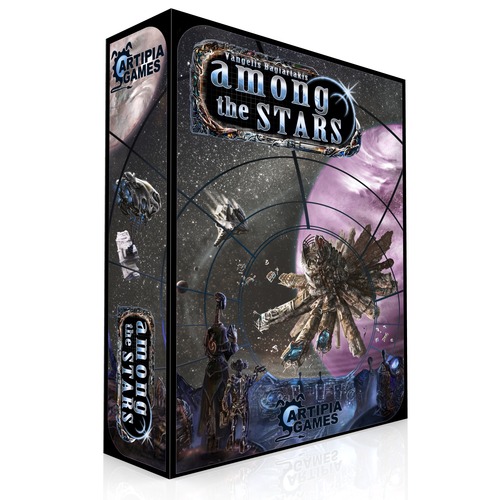
The Basics:
- For ages 12 and up
- For 2 to 4 players
- Approximately 30 minutes to complete
Geek Skills:
- Counting & Math
- Logical & Critical Decision Making
- Reading
- Pattern/Color Matching
- Strategy & Tactics
- Visuospatial Skills
- Hand/Resource Management
Learning Curve:
- Child – Moderate
- Adult – Easy
Theme & Narrative:
- At the end of a great intergalactic war, peace is declared and space stations are built to keep the peace – you are in charge of building one of these spaces stations
Endorsements:
- Gamer Geek approved!
- Parent Geek rejected!
- Child Geek rejected!
Overview
Not too long ago, space was a battleground. Many fought and died among the stars. That time has passed and peace has been declared by all the warring races. In an effort to keep the peace and establish meaningful relationships built on trust and trade, the new governing body known as the Alliance has ordered all space-faring civilizations to build space stations to be a beacon of peace and friendship in the darkness of space. You have been hand-selected to represent your race and construct such a space station. You have limited time and resources, but you must succeed for the betterment of all.
Among the Stars, by Artipia Games, is comprised of 4 Main Reactor cards (Square 7x7cm), 72 Basic Location cards (Square 7x7cm), 44 Special Location cards (Square 7x7cm), 12 Power Reactor cards (Square 7x7cm), 8 Objective cards (Square 7x7cm), 12 Conflict cards (Square 7x7cm), 8 Racial Abilities (8x5cm punched board), 1 Score Board (16.8cm x 26cm), 4 Player marker hexes (punched board), 1 Turn marker hex (punched board), 32 1-credit tokens (punched board), 12 5-credit tokens (punched board), 30 Energy Cubes (transparent plastic 1.2×1.2×1.2cm), and Ziplock PE-Bags to help organize all the bits. As this is a review of the final prototype, and the reported final product contains much more than we were provided, we will not comment on the game’s component quality. We would like to point out, however, that the final artwork for the game is gorgeous.
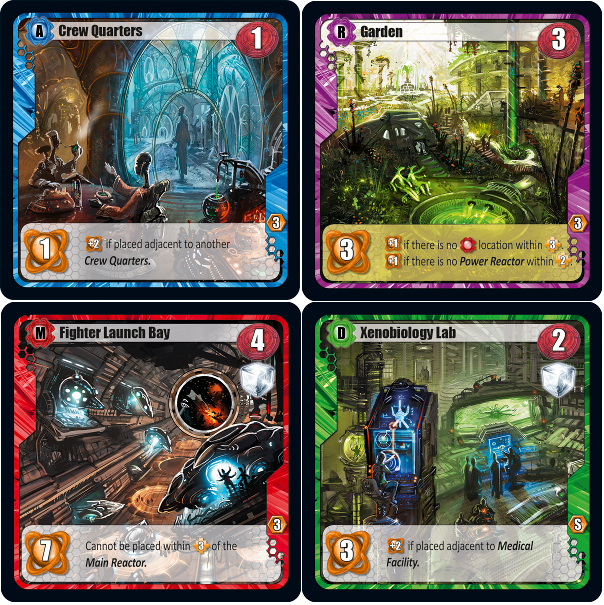
Example of proposed final artwork and card design
Game Set Up
There are two ways to play the game. These are Aggressive and Non-Aggressive. As the titles suggest, the difference in play is based around the level of player interaction. Depending on what type of game the players want, the game set up is different.
Non-Aggressive Game Play
First separate all the Basic Location cards from the Special Location cards and the Power Reactor cards. The Special Location cards have a symbol on their lower right-hand corner. Create a deck for each card group (Basic, Special, and Power Reactor cards) and shuffle. Find and shuffle the Objective cards, too, but these are not yet used and might not be needed.
Second, remove all the Basic Location cards with the number “4” in the lower right-hand corner for the duration of the game if playing with 3 players. For 2 and 4-player game, these cards are kept.
Third, randomly draw 6 Special Location cards per player. For a 2-player game, 6 cards are drawn for the two “virtual players”. These cards are added to the Basic Location card deck. Shuffle the Basic Location card deck with the newly added Special Location cards and place face-down. This stack of cards is now referred to as the Location deck. The remaining Special Location cards are removed for the duration of the game.
Fourth, place the Score Board in the middle of the playing area and have each player select 1 Player Marker. The Player Markers are placed on the Score Board on the spot with the number value of zero. It is recommended in the rules that one player keep track of the points for ease of play, much in the same way it is done in other games. For example, Alahambra. For a 2-player game, the “virtual players” do not place a Player Marker on the Score Board.
Fifth, have each player select a Main Reactor card and place it on the table in front of them and collect 2 Energy cubes. These two Energy cubes are placed on the Main Reactor card. All the remaining Credits and Energy cubes are placed in the center of the playing area and within easy reach of all the players. This area is now referred to as the Supply. For a 2-player game, the “virtual players” do not get a Main Reactor card or Energy cubes.
Sixth, have each player now select a race to play (either randomly or by choice) and take the tiles with the race’s noted Racial Ability. For a 2-player game, the “virtual players” do not select a race. If playing the game for the first time, you can skip the selection of Racial Abilities.
Seventh, have each player now select 1 Objective card. These cards are placed face-up in front of all the players and can be looked at anytime during the game. For a 2-player game, each player will only select 1 Objective card each. If playing the game for the first time, you can skip the selection of Objective cards.
Game set up is now complete for Non-Aggressive game play.
Aggressive Game Play
Follow all the steps noted above for Non-Aggressive Game Play set up. In addition, find and separate the 12 Conflict cards. Shuffle this deck randomly and draw a number of cards equal to 3 times the number of players and place face-down. Do not look at these cards at this time. Place this stack of cards in the middle of the playing area for now. Discard any remaining Conflict cards.
Game set up is now complete for Aggressive game play.
Building Space Stations
Note: This review only summarizes the actions taken during the game. For full details, please refer to the game rules.
The game is played over a 4 years (in game terms) with each year considered a single round. In other words, 4 rounds. All the player interaction and building will take place during these rounds, and once a round is complete, a new round begins until the game ends.
At the beginning of each round (or year), each player will take 10 Credits and draw 6 Location cards. Players should not show other players their Location cards. The Turn Marker on the Score Board is moved to indicate the correct year. Also noted on each year is the direction of play that indicates in which direction cards will be passed to other players. Every round consists of 6 turns wherein all players will be playing the game simultaneously. On each turn in the round, a player can select one of the three possible actions:
Build Location
Using any of the currently available Location cards in their hand, the player may build one and place it in front of them. They must comply with the following rules.
- All Location cards must be adjacent to each other (orthogonally). As their space station increases in size, any Location cards that are diagonal to each other are valid, but are not considered adjacent in game terms.
- A player must pay for the Location card. Each Location Card costs so many Credits, which are noted in the upper right-hand side corner of the card. Additionally, some Location cards might also require Energy. The Credits are paid back to the Supply but Energy must come from the space station. Energy is paid for by shifting Energy cubes that must be no further than 2 Location cards away. All distance is counted orthogonally with each Location card counting as a distance of 1. Initially, each player will start with a Main Reactor that will supply power and is the hub of the space station. As the game continues, players can acquire Power Reactor cards.
Once the Location card is successfully built, the player’s victory points on the Score Board are increased by the number indicated on the lower left-hand corner of the Location card.
Any Location card that has instructions written in a white box are followed immediately afer the Location is played.
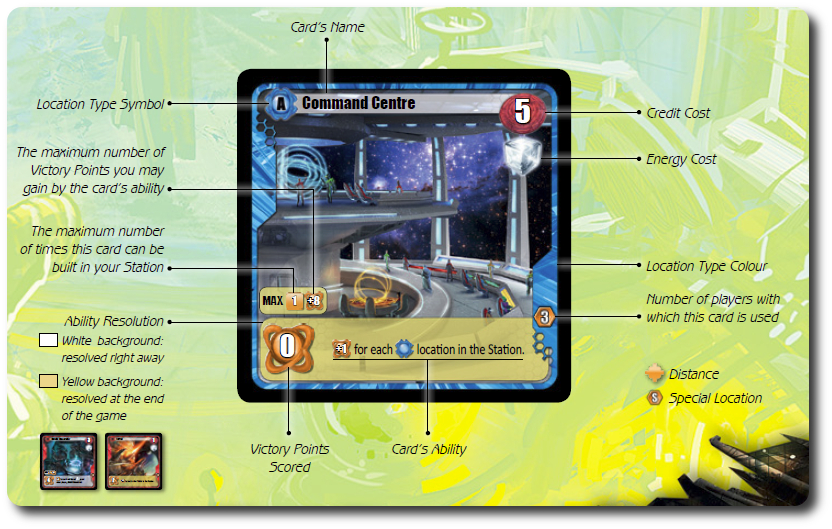
Build Power Reactor
Power is necessary to bring any new location on the space station online and a requirement for all builds. To play a Power Reactor card, the player discards a selected card from their hand (showing it to all the players), pays its cost which is only 1 Credit, and then takes 1 Power Reactor card from the Power Reactor card deck.
Like Location Cards, Power Reactors must be built and placed to an adjacent card already in play. Unlike Location cards, Power Reactors get two Energy cubes on it once it played to be used later to power other locations.
If the Power Reactor deck has run-out, the player cannot take this action.
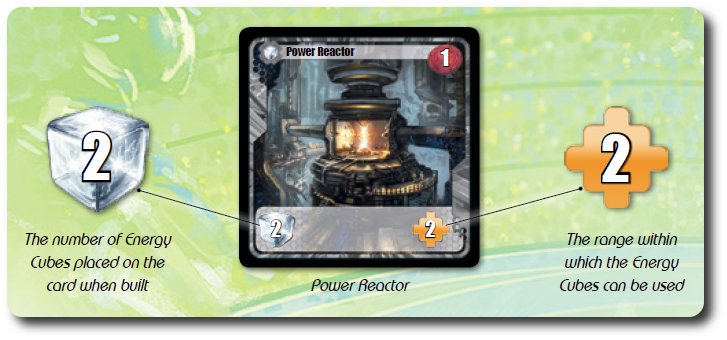
Discard and Gain 3 Credits
If the player cannot build a new Location, take a Power Reactor card, or simply chooses not to, they can discard one card from their hand and collect 3 Credits.
Once all the players have taken their action, revealing what cards they used to complete it and taking the necessary steps, the turn ends. All the remaining cards in the player’s hand are then passed to the player to their left or to their right as directed by the turn indicator on the Score Board. Once the last of the cards have been played (meaning there are no cards left to pass to the next player) the round and year ends.
Special Rules for 2 Players
During a 2-player game, the players give their remaining cards to the “virtual player” to their left or right (depending on the direction the cards are passed). The “virtual player’s” hand is shuffled and one card is removed and discarded at random to a special discard pile for “virtual players”. This discard pile can be looked at by the other players at any time. The player then takes the cards from the other “virtual player” to be used as their hand for the next turn (which should also have a card removed from it). By the time the next turn in the round beings, all players (both real and virtual) should have the same number of cards in their hand.
Racial abilities used by the players that allow them to look at the hands of other players can also be used against “virtual players”, but not abilities that target specific locations or objectives (since “virtual players” don’t have any to speak of).
The game play for a 2-player game continues as normal.
The End of a Productive Year
After the turns are completed in the round (with no cards left), the round ends. Every player should now take a look at their own space station and their neighbors to make sure the build was correct. If an error is found, the player who owns the incorrectly built space station must remove as many Locations as necessary until the space station build is corrected. These removed cards are discarded. The player also looses victory points and their score is adjusted on the Score Board accordingly, but they do not receive any Credits previously spent on removed cards.
If the removal of a Location card severs the space station into two or more parts (indicated by not having an orthogonally placed Location card next to each other), a Power Reactor card is drawn and placed face-down. This is a dead space, does not provide power, and is only meant to be a placeholder. These spaces are not counted for points and also serve as a visual reminder to watch how you build your station.
Aggressive Behavior
If playing an Aggressive Game, the second year (second round) of the game allows for players to start being more aggressive towards the other players.
Starting on the second round and continuing for the duration of the game, randomly draw and shuffle in a number of Conflict cards that is equal to 3 times the number of players (for example, a 3-player game will mean you shuffle in 9 Conflict cards) into the Location card deck.
Starting on the second round and continuing for the duration of the game, each player will now draw a seventh Location card from the deck instead of “6”. Conflict cards cannot be built but are played as the player’s action for a turn by paying 1 Credit and taking any actions as noted on the card.
There are no other changes to the game play and Conflict cards can be discarded to complete the other actions as required.
Open for Intergalactic Business
At the end of the fourth year (fourth round), the game is over and all players now calculate their points to determine the winner. This should be done after each player checks their neighbor’s space station for illegal builds. Once the space station builds have been verified, additional points are counted as follows:
- Check all the cards in the Space Station with text in yellow boxes for additional victory points
- Gain 1 victory point for every Power Reactor that DOES NOT contain any Energy cubes (i.e. used Power Reactors)
- Gain 1 victory point for every 3 Credits the player still has in their possession
- Gain any victory points provided by completed Objectives (if used in the game). Each Objective can only be claimed by 1 player unless stated otherwise. If 2 or more players are tied for any Objective, no bonus is given.
Once all the points are accounted for, the Score Board is adjusted, and the player with the most victory points wins the game. If there is a tie, it is broken by counting the number of Location cards (excluding Power Reactors and dead spaces) with victory going to the player with the most. If there is still a tie, victory goes to the player with the most Credits. If there is a still a tie, have the players enter Thunderdome and place your bets.
Game Variants
There are two game variants provided in the rules that change the game slightly.
- All-In: this game variant changes the normal game set up and has all the Basic and Special Location cards shuffled together. This is the Location deck used for the duration of the game. This variant decreases set up time and increases game difficulty by making it much less predictable.
- Limited Space in Space: this game variant restricts the building space given to each player. A normal game has no limits (build off the table if you want and shift your cards as needed to create space). This is not allowed in this game variant and the players cannot shift their Location cards to make room. The limits to their build area is defined by their playing space and the other players around them. If this game variant is used, we highly suggest you move the Score Board, all decks, and the Supply off the table.
To learn more about Among the Stars and read the full rules, see the game’s web page.
Prediction
My little geeks, friends, and family can all play 7 Wonders, which Among the Stars has often been compared to. However, it doesn’t take a trained eye to immediately recognize that Among the Stars is a much more involved and complicated game. This means the only aspect I can predict for the test groups is the way in which the cards are passed and used, but not how they will be played. The variable racial abilities and card powers add to the level of difficulty to predict the game’s overall endorsement, as well.
If we take what we have learned just from reading the rules, I would predict this game will be much too complicated for the Child Geeks, too involved for the Parent Geeks, and loved by the Gamer Geeks. Each test group has their special “hook” that makes a game easy to predict. While the theme of the game will appeal to the Child Geeks, the game play might be too advanced for them to fully grasp. The Parent Geeks will certainly enjoy the casual play of the game as they did in 7 Wonders, but the level of attention to detail and focus might make the game feel too heavy. Gamer Geeks could probably tell you if they will enjoy the game or not based off a summary description.
Explaining the basic rules of the game doesn’t take long. Explaining how the Location cards work and how powering locations does. Child Geeks had a hard time grasping this and the Parent Geeks kept saying it sounded really difficult. Gamer Geeks just smiled and said, “go on.” After demoing every aspect of the game I could, I sat down with my 8-year-old to play the game. My 5-year-old had lost interest early on and decided the game was just too involved for him to enjoy. Additional, the reading of the cards made it difficult for him to play the game well and I couldn’t really read the cards for him as that would give me a big advantage in the game.
As my little geek and I set up the game for our first play, I asked him his thoughts on it so far.
“Well, I don’t think the game sounds hard but I think I’m going to have a hard time winning. Lots to think about.” ~ Liam (age 8)
Very true. There is a lot to think about and just not what cards to select. A player must constantly evaluate their space station and create an efficient build. That, in itself, is hard enough. Now randomize what pieces you have available to you and player interaction that could mess you up (be in selecting cards you could use or aggressive moves with Conflict cards), and the game becomes that much more difficult. His early opinion on the game is very well thought out, but also leaves room for his natural level of optimism. Let’s see if the game proves to be too much for him and others or surprises us all and rewards our game play with out-of-this-world awesomeness.
Final Word
This game took longer to review with our test groups for two reasons. First, it’s summer time. Everyone is gone and running around with their families. Hard to get people to the game table if they are nowhere near it. Second, this game looks intimidating. Getting players to sit down and want to play it took some effort. It always amuses me when people start backpedaling from a game based on its theme or component bulk.
As predicted, the Child Geeks loved the theme but couldn’t play the game well enough to really enjoy it. They had no problem with the card passing and turn actions, but became quickly lost when they had to start making choices. Analysis paralysis was everywhere and the level of frustration grew exponentially during each round. The end result was a game they liked to look at but did not like to play. This was true for every Child Geek we had the great fortune to play the game with. I can only hope we did not burn any bridges with them or their parents.
Parent Geeks also had a hard time with this game, but not for the same reasons as the Child Geeks. They could build their space stations easily enough, but the game took too much of their brain power. A casual game this is not. While it didn’t outsmart them by any means, they reported that the game felt too demanding, too involved, and did not provide for a casual game experience. The Parent Geeks who were also Gamer Geeks enjoyed it immensely and wanted more. None of the non-gamers showed the game much thought. I interpreted their lack of interest as fear.
Gamer Geeks? They loved it.
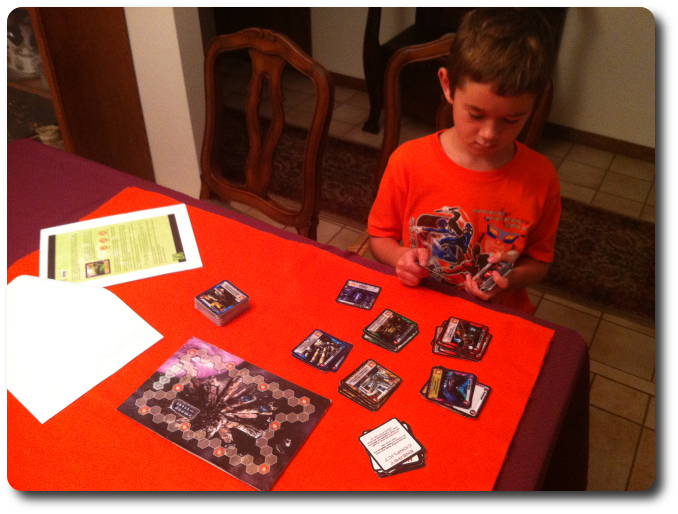
The calm before the storm…My little geeks looks through the cards to familiarize himself with his many options
Gamer Geeks, Among the Stars is a challenging game that requires you to think ahead, react intelligently to game changes, and always focus on reevaluating your current position in relationship to your opponents. We think you’ll enjoy the many different options available to you and the different ways to build your space station to claim victory. The different special abilities provide new and interesting strategic and tactical choices and the random Location cards makes for a different game experience every time. Playing the Aggressive Game play is a must once you get used to the game.
Parent Geeks, our test groups suggest that the game is not nearly casual enough to be enjoyed at your family gaming table with friends and family. But don’t take our word for it, or theirs. Consider the audience this game is intended for. Specifically, individuals who like a civilization games with card drafting and variable powers. If this sounds like a game you and your family would enjoy, then go for it. Keep in mind, however, that the game level of thought needed in the game is higher than your typical casual game and there is a great deal of reading and thinking several moves ahead that is required by the players to build a good space station.
Child Geeks, this is not a game you will be able to play easily. There is a lot to think about, but not so such as to imply it is impossible to comprehend. There is just too much game here for you to play it competitively. We do encourage you to look at the cards and enjoy the artwork, as they are going to be stunning. This is a game you should start to familiarize yourself with as it will be a great deal of fun for you to play when you have the time, the energy, and the skill to tackle it fully. Until then, the game is waiting for you and eagerly awaits your attention.
I have been very public with my lack of love for 7 Wonders. I have yet to really enjoy the game and didn’t think I’d like Among the Stars based on the early reports that the games were similar. Yes, they are similar in regards to how the cards are passed, but that’s where it stops. There is a lot more game in Among the Stars than the base game of 7 Wonders, and as a result, much more enjoyable for me. I loved the building aspect and the level of thought I had to give each Location card and consider my power options. The ability to gather Credits was a nice touch and gave me even more options during play. I never felt like the game was putting me in the corner or was forcing me to play the game in a way I didn’t feel comfortable. The theme was well received and I’m sure the alien races will add a wonderful level of new game play experience that will compliment the objectives. The game felt very complete, well thought out, and truly enjoyable. I was eager to play it again as soon as the first game was over and I thought to myself, “maybe this is what people who love 7 Wonders feel like.” But I doubt it. I think Among the Stars is a much better game. Feel free to leave your passionate opinions that state how wrong I am below.
If you are looking for a space station building, science fiction themed, simultaneous player action card drafting game that will not only challenge the way you think about your moves but also how you build, then do reach for Among the Stars.
This game was given to Father Geek as a review copy. Father Geek was not paid, bribed, wined, dined, or threatened in vain hopes of influencing this review. Such is the statuesque and legendary integrity of Father Geek.



